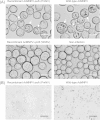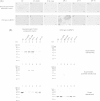The genome and occlusion bodies of marine Penaeus monodon nudivirus (PmNV, also known as MBV and PemoNPV) suggest that it should be assigned to a new nudivirus genus that is distinct from the terrestrial nudiviruses
- PMID: 25063321
- PMCID: PMC4132918
- DOI: 10.1186/1471-2164-15-628
The genome and occlusion bodies of marine Penaeus monodon nudivirus (PmNV, also known as MBV and PemoNPV) suggest that it should be assigned to a new nudivirus genus that is distinct from the terrestrial nudiviruses
Abstract
Background: Penaeus monodon nudivirus (PmNV) is the causative agent of spherical baculovirosis in shrimp (Penaeus monodon). This disease causes significant mortalities at the larval stage and early postlarval (PL) stage and may suppress growth and reduce survival and production in aquaculture. The nomenclature and classification status of PmNV has been changed several times due to morphological observation and phylogenetic analysis of its partial genome sequence. In this study, we therefore completed the genome sequence and constructed phylogenetic trees to clarify PmNV's taxonomic position. To better understand the characteristics of the occlusion bodies formed by this marine occluded virus, we also compared the chemical properties of the polyhedrin produced by PmNV and the baculovirus AcMNPV (Autographa californica nucleopolyhedrovirus).
Results: We used next generation sequencing and traditional PCR methods to obtain the complete PmNV genome sequence of 119,638 bp encoding 115 putative ORFs. Phylogenetic tree analysis showed that several PmNV genes and sequences clustered with the non-occluded nudiviruses and not with the baculoviruses. We also investigated the characteristics of PmNV polyhedrin, which is a functionally important protein and the major component of the viral OBs (occlusion bodies). We found that both recombinant PmNV polyhedrin and wild-type PmNV OBs were sensitive to acid conditions, but unlike the baculoviral OBs, they were not susceptible to alkali treatment.
Conclusions: From the viral genome features and phylogenetic analysis we conclude that PmNV is not a baculovirus, and that it should be assigned to the proposed Nudiviridae family with the other nudiviruses, but into a distinct new genus (Gammanudivirus).
Figures








References
-
- Lightner DV, Redman RM. A baculovirus-caused disease of the penaeid shrimp, Penaeus-monodon. J Invertebr Pathol. 1981;38(2):299–302. doi: 10.1016/0022-2011(81)90137-3. - DOI
-
- Lightner DV, Redman RM, Bell TA. Observations on the geographic-distribution, pathogenesis and morphology of the baculovirus from Penaeus-monodon Fabricius. Aquaculture. 1983;32(3–4):209–233. doi: 10.1016/0044-8486(83)90220-X. - DOI
-
- Mari J, Bonami JR, Poulos B, Lightner D. Preliminary characterization and partial cloning of the genome of a baculovirus from Penaeus-monodon (Pmsnpv = Mbv) Dis Aquat Organ. 1993;16(3):207–215. doi: 10.3354/dao016207. - DOI
-
- Jehle JA, John B, Herniou E, Elisabeth H, Robert H, Basil A, David T, van Oers M, Becnel J. Creation of a new family Nudiviridae including two new genera and three species. 2013.
Publication types
MeSH terms
Substances
Associated data
- Actions
LinkOut - more resources
Full Text Sources
Other Literature Sources

